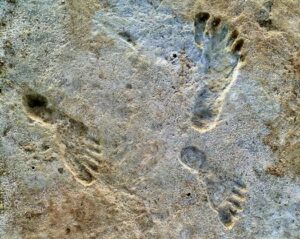
AMERICAN ASSOCIATION FOR THE ADVANCEMENT OF SCIENCE (AAAS)—New radiocarbon (14C) and optically simulated luminescence ages have confirmed the controversial antiquity of the ancient human footprints discovered in White Sands National Park, and reported in a study* in 2021. Addressing the widespread criticism of their previous study, researchers report that the independent ages from multiple resolved sources conclusively show that the footprints were left behind between roughly 23,000 and 20,000 years ago, demonstrating that humans were present in southern North America during the Last Glacial Maximum (LGM).
When and how humans first migrated into North America has long been debated and remains poorly understood. Current estimates for the timing of these first occupants range from ~13,000 years ago to more than 20,000 years ago. However, the earliest archaeological evidence for the region’s settlement is sparse and often controversial. In a Science study published in September 2021 (Bennett et al.), researchers reported the discovery of in situ human footprints preserved in an ancient lakebed dating to between ~23,000 and 21,000 years ago in what is now White Sands National Park – findings which suggest nearly 2,000 years of human occupation in North America during the height of the LGM. However, since the study’s publication, the accuracy of the radiocarbon dates has been debated. It’s argued that the ancient seeds from the aquatic plant (Ruppia cirrhosa) that were used to date the surfaces the footprints were embedded in have the potential to be affected by old carbon reservoir effects that could influence the reported radiocarbon ages and make them appear older than they truly are.
Here, Jeffery Pigati, Kathleen Springer, and colleagues report new evidence in the form of multiple independent age estimates of the White Sands footprints, which support their previous study’s claims. “We always knew that we would have to independently evaluate the accuracy of our ages to convince the archaeological community that the peopling of the Americas occurred far earlier than traditionally thought,” said Pigati.
In their new work, Pigati and Springer et al. present calibrated 14C ages of terrestrial pollen collected from the same stratigraphic contexts as the Ruppia seeds. Unlike the seeds, conifer pollen fixes atmospheric carbon and, therefore is not subject to potential old carbon reservoir effects. According to the findings, the resulting calibrated 14C ages range from 23.4 ± 2.5 – 22.6 ± 2.3 thousand years ago. In addition, the authors obtained optically simulated luminescence ages of the sediments from within the footprint-bearing strata, which produced a minimum age of 21.5 ± 1.9 thousand years ago. In both cases, Pigati and Springer et al. show that the resolved dates were statistically indistinguishable from the original calibrated 14C ages of the oldest Ruppia seeds reported previously. In a related Perspective, Bente Phillipson discusses the study and its findings in greater detail.
“Even as the original work was being published, we were forging ahead to test our results with multiple lines of evidence and independent chronologic techniques,” said Kathleen Springer, co-lead author of the study. “Although we were confident in the original seed ages, we wanted to develop community confidence in them as well. Our new ages, combined with the strong geologic, hydrologic, and stratigraphic evidence, unequivocally support the conclusion that humans were present in North America during the last Glacial Maximum.”
_________________________________
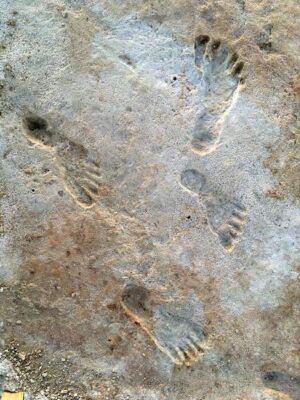
Above and below: Human footprints at study site. National Park Service
_________________________________
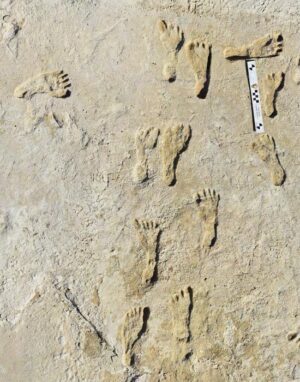
_________________________________
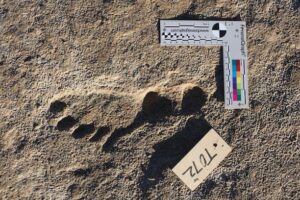
A single human footprint at site. National Park Service
_________________________________
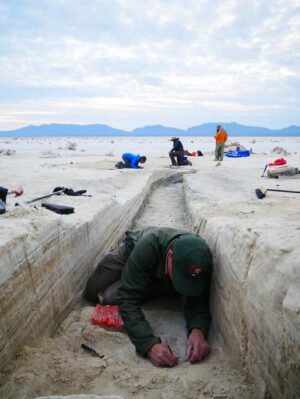
The study site trench with White Sands National Park Resource Program Manager, David Bustos in foreground. National Park Service
_________________________________
Article Source: AMERICAN ASSOCIATION FOR THE ADVANCEMENT OF SCIENCE (AAAS) news release.
*Independent age estimates resolve the controversy of ancient human footprints at White Sands, Science, 6-Oct-2023. 10.1126/science.adh5007
_________________________________
Advertisement

See the incredible archaeology, architecture, and art of northern Spain. A unique tour with special expert guides and lecturers through the collaboration of Popular Archaeology Magazine and Stone & Compass Tours. Not to be missed. Read More About It: https://popular-archaeology.com/article/northern-spains-triple-a-archaeology-architecture-and-art/.
_________________________________





